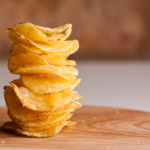A few days ago, I read an article in a mainstream media newspaper about a mum who challenged her child’s primary school concerning the packed lunch she’d made him.

The school demanded the child ate his lunch in a certain order, resulting in him having nothing to eat at all as he’d refused and wasn’t allowed to eat the ‘pudding’ course of his lunch. As you’d expect, the comments were a mixed bag – parents agreeing with the school, parents disagreeing with the school, and teachers clarifying ‘their responsibility’ to teach children nutrition. In my personal view, they should offer advice and encouragement but not blanket rigid enforcement.
 Mealtimes should never be a battle. It’s simply a stressful lose:lose situation. Young children, toddlers in particular, can be the most stubborn little brick walls. Parents understandably want the child to eat, but, unless there’s medical reasons that the child absolutely must eat, it’s not going to hurt them to miss a meal if they refuse. They’ll come back when they’re hungry.
Mealtimes should never be a battle. It’s simply a stressful lose:lose situation. Young children, toddlers in particular, can be the most stubborn little brick walls. Parents understandably want the child to eat, but, unless there’s medical reasons that the child absolutely must eat, it’s not going to hurt them to miss a meal if they refuse. They’ll come back when they’re hungry.
Food is something you learn to like. Tastes develop as you grow. Just like adults, children ‘eat with their eyes’. This is the very reason food corporations produce dinosaur chicken pieces, fishy shaped fish ‘fingers’, yoghurts with cartoons on them etc.
When parents and grandparents, like me, are feeding their little darlings, they’ll know the favourite ‘go to’ to make the child eat. When they go on to nursery or school, if they’re taking a packed lunch, you want to ensure that they actually eat something in the middle of the day and not be a grouchy hungry little beast all afternoon. In an ideal world, this packed lunch will be perfectly nutritious and healthy. But, kiddies don’t understand the concept of an ideal world! So you pack what you know they will eat.
 One of my children had the exact same lunch every single day of primary school – a completely plain ham sandwich – nothing added, not even butter on the bread! Goodness knows what the school thought of me, but it meant he ate. As a baby and toddler he just hated chewing. Everything had to be soft and sloppy – he pretty much lived off fromage frais for a year! I’d already had 2 children before him and learned the hard way what trying to force a toddler to eat results in – plenty of bolognaise stains on the carpet to prove it. So, I had a much more relaxed attitude the 3rd time round. And guess what, none of the children ended up under-nourished or under-fed. As an adult, the child in question will now try absolutely any food and is probably the most adventurous eater of the 3.
One of my children had the exact same lunch every single day of primary school – a completely plain ham sandwich – nothing added, not even butter on the bread! Goodness knows what the school thought of me, but it meant he ate. As a baby and toddler he just hated chewing. Everything had to be soft and sloppy – he pretty much lived off fromage frais for a year! I’d already had 2 children before him and learned the hard way what trying to force a toddler to eat results in – plenty of bolognaise stains on the carpet to prove it. So, I had a much more relaxed attitude the 3rd time round. And guess what, none of the children ended up under-nourished or under-fed. As an adult, the child in question will now try absolutely any food and is probably the most adventurous eater of the 3.
So, getting back to the beginning, my view is that schools should back off a bit. There is nothing wrong with a bit of encouragement – explain to the child that eating their sandwich/pie/savoury protein portion first is a good thing. But, if they want to begin with their yoghurt pud then let them. It’s all food, it’s all going to the same place. The parent/caregiver who’s packed the lunch has selected items the child will eat. Don’t get me wrong, I’m not advocating that Little Johnny gets away with having nothing but a bar of chocolate and salty crisps every day – it’s up to the parent to ensure that their choices are better selected. Schools can feed back to parents if a child is consistently disregarding the ‘better’ foods in their lunch or assist parents if they appear to be solely providing sugary, fatty, processed food. Not everyone has the knowledge to produce a healthy meal.
A perfect lunchbox would include each of the 5 food groups – Protein, Carbohydrates, Dairy, Fruit and Veg, and Fats and Sugars. Usually, these will be combined – a ham sandwich covering both protein and carbohydrates, for example. A bag of crisps may not be healthy, but alongside a sandwich it makes the lunch more appetising. This doesn’t have to be a commercially produced over-salted bag of fake flavourings and preservatives. You can very easily make your own.
 Home made crisps
Home made crisps
- Potatoes (skin on or off as preferred)
- Olive oil
Pre heat your oven to 200°.
- Scrub the potatoes, peel if preferred, pat dry.
- Slice the potatoes thinly – a mandolin is ideal, or the slicing side of your grater. But if good with a sharp knife you can slice them manually – but no more than about 3mm thick.
- Pop the slices into a bowl with a little olive oil and toss them so each slice is lightly coated.
- Spread the slices onto a lined baking tray, without overlapping them, and bake in the oven for about 8-10 minutes. Then turn them and continue baking for another 8-10 minutes. Check them after about 6 minutes as they can overcook easily, especially if very thin.
If you want to add any seasoning, do so as soon as you remove them from the oven while still hot. They can be eaten plain without any added seasoning, but good sea salt and pepper, herbs such as rosemary or sage, paprika or chilli, or even a sprinkle of parmesan are all lovely.
You can make crisps out of many vegetables – beetroot, parsnips, sweet potato, carrots – in exactly the same way.
My grandson can be extremely picky over food one day and eat absolutely anything the next (sadly this includes Playdough!) but one failsafe is cheese. He adores cheese. He’s been known to have pretty much nothing but cheese for meals. If taking him out for the day and needing to take a lunch along, I might add in a sandwich (cheese of course) but he’s more likely to eat chopped up cheese cubes, some raisins, a cheese straw, mini cheesy biscuits and a fromage frais. He will eat strawberries too, but there’s many fruits he still isn’t fond of. I would love to produce a beautiful box with raw vegetables, fruits and super healthy proteins, but when out of the house you don’t have the time or frankly the strength for trial and error, you just want them to eat something and not be hungry.

If your child prefers to ignore the sandwich, you may find it helps to make it more attractive – learn from the food companies. Use biscuit cutters to produce shaped sandwiches for example. If your child dislikes bread, why not make wraps instead or roll a filled tortilla and slice it up into pinwheels.
Don’t be overly fancy with fillings – they’re more likely to eat a simple cheese spread sandwich than a salmon and cucumber. A variety of small things is better than just one or two larger items.
When your child goes to nursery or school, it’s worth checking out what their philosophy is for packed lunches. If it feels too strict for you, have a chat with them. Explain your own personal view and any peculiarities your child has. If you have a very picky eater, and just want to ensure they eat something rather than nothing, tell the school you will add multiple items into the lunchbox with the intention that the child will find something they want to eat. But, explain that you aren’t expecting them to eat every single thing so they don’t force them to sit until their lunchbox is empty. It may even be worth adding a little note in the box every day stating that the box is over-filled and you expect some to come home again but you want the child to choose. You can help the situation by limiting items such as chocolate bars and over-processed food or snacks.
Have some fun when preparing a child’s lunchbox – see it through their eyes. Enjoy playing with shapes, and have everything bite-sized for easy grazing. The odd sliced strawberry cut into a heart shape is cute.
Love
Maggie x

